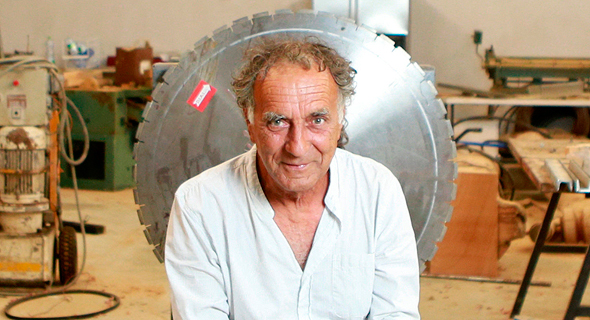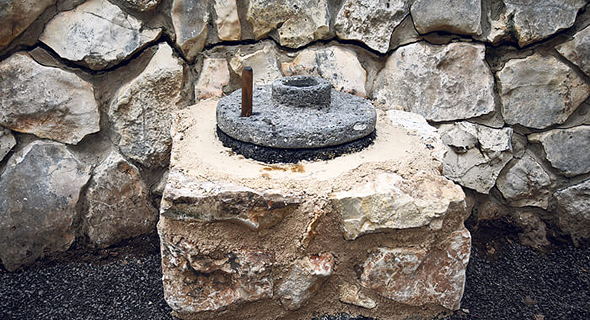Interview
Need to restore ancient tech? Just call Jesus
Yehoshua (Jesus) Drai specializes in restoring archeological artifacts and figuring out how they were used centuries ago
09:2706.03.21
What does a restorer of ancient technology do?
 Yehoshua (Jesus) Drai. Photo: Amit Shaal It’s a shame more people don’t take an interest in such things and don’t realize the path humanity has taken to arrive at where we are now. The biggest tragedy will be if we experience a real catastrophe that bars us from using electricity. We will revert back to before the stone age because people don’t know how to make things out of rocks. People would starve to death.
Yehoshua (Jesus) Drai. Photo: Amit Shaal It’s a shame more people don’t take an interest in such things and don’t realize the path humanity has taken to arrive at where we are now. The biggest tragedy will be if we experience a real catastrophe that bars us from using electricity. We will revert back to before the stone age because people don’t know how to make things out of rocks. People would starve to death.
 A historic waterwheel restored by Drai Occasionally I’ll bring to the hangar things that I salvage, like stones that were revealed under a store in Jerusalem’s Old City. The store’s owner was granted the land from the Antiquities Authority after their excavation was done and wanted to throw them away until I discovered that his find was the first of its kind in Israel— they were part of an animal-powered mill. He agreed to give them to me and I will reconstruct the mill as an exercise for students.
A historic waterwheel restored by Drai Occasionally I’ll bring to the hangar things that I salvage, like stones that were revealed under a store in Jerusalem’s Old City. The store’s owner was granted the land from the Antiquities Authority after their excavation was done and wanted to throw them away until I discovered that his find was the first of its kind in Israel— they were part of an animal-powered mill. He agreed to give them to me and I will reconstruct the mill as an exercise for students.
 An ancient press restored by Drai. In my opinion, all archeologists should be made to take an oath like physicians, because everything they handle is destined to be destroyed. When you handle these delicate layers, you’re destroying what was there before and if you peeled off a layer and didn’t document it — it’s lost forever. As an archeologist you are obligated to relay the information to future generations, that’s your duty, what you were trained for. But the only records most of them keep are of their own problematic interpretations.
An ancient press restored by Drai. In my opinion, all archeologists should be made to take an oath like physicians, because everything they handle is destined to be destroyed. When you handle these delicate layers, you’re destroying what was there before and if you peeled off a layer and didn’t document it — it’s lost forever. As an archeologist you are obligated to relay the information to future generations, that’s your duty, what you were trained for. But the only records most of them keep are of their own problematic interpretations.
Archeology deals with the attempt to understand the ancient world based on its material culture — you find artifacts such as pots and pans and by studying them, try to understand the person who used them. The closer you can get to restore the ancient technology behind the artifacts, the closer you get to the person who made or used them.
What is ancient technology anyways?
The word ‘technology’ may sound modern, but when people used flintstones to manufacture tools 20,000 years ago, they were essentially applying a technological process. Over the years I have dealt with many different technologies, from bleaching linen fibers to casting bronze and iron to make coins to producing oil candles. The most prominent technologies in my research are for food production, things like oil or wine presses.
 Yehoshua (Jesus) Drai. Photo: Amit Shaal
Yehoshua (Jesus) Drai. Photo: Amit Shaal How are you different from an archeologist?
A senior archeologist I work with once said about me: “Jesus is the guy who archeologists call after they have been digging for a year or two to ask what it is they have dug up.” When they encounter something they’ve never seen before, I’m the guy they call. Occasionally I take an active role in the dig, but the site doesn’t interest me. I only care about the artifacts that are found. Every project requires intense research. I can sit back to back with my partner for weeks at a time, each of us at our computers, going through libraries all over the world to try to identify things that no one has ever seen before. I don’t know if I’m a hundred percent correct in my insights, but you won’t find any better answers than those I provide.
It is because I’m not an archeologist by training that I can think about things in a completely open way, I’m not dictated by the enshrined methodologies of the academic world. Those things really kill any creative thoughts. Two years ago I arrived at an excavation site in a place where they used to make candles. The dig manager asked me to help him define the technology they had used and gave me a totally bogus account of how he thought they used to make them. We got into a big fight over it. I ended up winning the argument and it’s because I have a big advantage over the academic scholars — I bring curiosity based on personal experience. The archeologists can mess around with their theses, but I bring literal hands-on experience. What could be better than empirical research? So I went and cast the candle molds, I actually made them, and we were able to decipher the technology that went into producing them.
How do you approach such research?
It all begins with coming up with a theory for how a certain thing functions. For example, I once went to a dig at an ancient sugar-making factory in Jordan, dating back to the Mamluk Sultanate (1250 until 1517). I was ecstatic about what I saw there: massive structures with presses and kilns. It was a real mega-industry. You take the sugar cane, crush or squeeze it, get all the liquid out, and then reduce it until the sugar in the solution crystallizes. As soon as I got there I started asking questions: did they use the press to squeeze it? How did they transfer the liquid to the kilns?
You work out of a big space. Why does a researcher need such a large hangar?
This is my playground. There’s no substitute for feeling the materials. I design mechanisms in my head, then make them. People understand how things work better when they see them working. That means I sometimes have to make an olive oil press from scratch, down to the nuts and bolts.
 A historic waterwheel restored by Drai
A historic waterwheel restored by Drai Who is your work meant for?
Universities, museums, and local authorities for the most part. If anyone in the country wants to establish an archeological park, the Antiquities Authority provides the artifacts, and they call me in to restore the exhibits.
What do you have against academia?
It’s very simple. You mustn’t box-in people’s minds. That’s what universities do. But you can’t do that with archeology. In this field, you have to have a 360 degree perspective on human life, in all its variety. Archeologists are terribly focused as if they have blinders on. It is an extraordinarily devastating science. They examine the artifacts they uncovered based on old theories and then import theories from other places to prove their own theses. But how do we know that the person who dug up something similar for the first time, a hundred years ago, had it right? Very few researchers actually question the old theories, they just confirm them and check a box. How do they know that the technique used in an oil press in one place applies to the oil press they’re excavating now?
 An ancient press restored by Drai.
An ancient press restored by Drai. How did you enter this unusual field?
It started in the army. We had a minesweeping exercise using metal detectors and I failed it. I didn’t find any mines, but I did find a coin. And then, boom! I felt that I had to get myself a device like that and find more coins. That’s what I felt was my calling. So I bought a metal detector and after my service crisscrossed Europe and Australia looking for treasure. The adrenaline rush comes from the search, that’s what is important, the artifacts you find are far less so. The moment I figured that out, working with archeologists became easy. I started out 25 years ago as a metal detector operator at excavations.
The breakthrough came at an excavation I was working on in an ancient winepress. A municipal official approached us and asked how they could restore something like that. So I just told him “I’ll do it for you.” The archeologist in charge tried to explain how he thought our findings worked, but it didn’t sit well with me. I straight away told him “nonsense, it wouldn’t work that way. My curiosity was activated by technical senses and I had to prove to him that I was right. I guess it turned out successful because it led to more restoration commissions and evolved into a full-time career. Today I am the only person in the country that deals with ancient crafts conservation.
Are you equally in tune with modern technology?
Modern technology has great advantages, even in my line of work. For example, I restored the ancient synagogue in Umm el-Qanatir using the most advanced technologies there are. I used a 3D digital scanner to scan a pile of rocks that collapsed from the structure and planted a smart chip in each instead of writing a number on them, which helped me figure out where each rock went. I’m not a big proponent of ‘going back to the simple days of old.’



